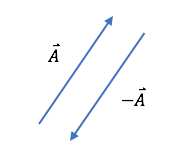Section 1.1 Introduction to Vectors
Subsubsection Key Ideas
Definition 1.1.2. Vectors.
A vector is a mathematical object with both a magnitude (a size or amount) and a direction.
In diagrams, vectors are represented by arrows. The length of the arrow represents the magnitude of the vector and the arrowhead indicates the direction of the vector. Symbolically, you draw an arrow on top of a symbol to denote a vector quantity, such as \(\vec{A}\text{.}\) On its own, the symbol \(A\) would represent the magnitude of the vector, which is sometimes written \(|\vec{A}|\text{.}\)
Definition 1.1.3. Scalars.
A scalar is a mathematical object that has a value (which can in general be either positive or negative) but has not direction.
Suppose you have a vector \(\vec{A}\text{.}\) The negative vector \(-\vec{A}\) has the same magnitude as vector \(\vec{A}\text{,}\) but points in the opposite direction.

Subsubsection Activities
Activity 1.1.1. Explore Vectors and Scalars.
Make a list of physical quantities you are familiar with from your everyday experience. For each quantity, do you think it would be better to represent it as a scalar or as a vector?
Activity 1.1.2. Explore Magnitude.
A vector is typically represented graphically by an arrow. Which property of the arrow do you think represents the magnitude of the vector? How would you represent two vectors that have the same direction but different magnitudes?
Answer.
The length of the arrow represents the magnitude of the vector. While for some vectors the length may be literal (for example, the magnitude may be measured in meters), most vectors will have different units, in which the physical length is only representing some other quantity, such as meters per second or newtons.
As a result of this, two vectors with the same direction but different magnitudes should be drawn parallel to each other, but with differing lengths.
References References
[1]
Vectors vs. Scalars by Dr. Michelle Tomasik from MIT 8.01 Classical Mechanics, Fall 2016, used under Creative Commons BY-NC-SA.
